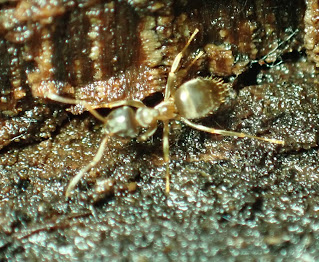 |
| L. americanus closeup- REK |
A while back I was moving a downed tree when the bark fell off and I was confronted with a frantic mass of ants. They were desperately trying to drag their young to safety as you can see in this Youtube video. After photographing them I covered up the crime scene with rotting bark. I sent a photograph to James Trager who identified them as Lasius americanus. According to James they are a woodland ant species that often lives in rotting wood, but also in sedge hummocks in fens, or simply in moist soil.
"It's a bit of a mystery what they eat, though honeydew from root-feeding aphids and related insects is known to be an important part of the diet. By the way, that brood you see is in fact larvae rather than pupae. Ant pupae look like tightly folded adult ants, or in the case of this species are in a cocoon, which shows no discernible head or other segments. The larva early in the video does appear to be a prepupa though, because it is all white, having eliminated the dark meconium, or larval gut contents."
 |
| Ant, aphid and honey dew dripping- James Trager |
He attached the picture above of another species in the genus, L. aphidicola with aphids on a tree root. Note the droplets of honeydew exuded by the aphids nearest the ant. Many ant species actually farm ants like dairy cows, protecting them from predators and lapping up the honeydew waste product, the ultimate in recycling.
According to Antwiki:
"This omnivorous species collects elaiosomes from seeds, live insects and carcasses of dead ones, and tends a wide variety of aphids, scales, and treehoppers, and coccids that feed on plant roots."
When exploring rotting logs, it pays to put them back as close to their original condition as possible. They will appreciate it, even it they don't wave goodbye. Or you can show your love by raising them, available online!
